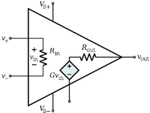preethi19
Full Member level 5
Hi i know resistance is for DC and impedance is for AC. Impedance is a combined effect of resistance, inductance and capacitance. In short the systems overall opposing effect for the flow of current. But i don't understand the part where in op-amp we need high input impedance and low output impedance. Like if impedance is a blocking effect won't it block the input signal if it is really high?
I came across the following from some posts
"Infinite input impedance would allow one to feed any amount of voltage into a load without it absorbing any power. Zero input impedance would allow one to feed any amount of current into a load without it absorbing any power." and also
"To get all the voltage from a source to a target without loss.
you need high input impedance."
So like from what i got from this is if you want to supply voltage to the input without it drawing any current(or really low current) is the need for high input impedance. but i am confused. Isnt voltage and current inter-related. As in how can we apply voltage to a point if current is not going to flow and if really low current flows just for the circuit to work what is the need for just requiring high voltage. What is wrong if high current flows too??? Because from the first post if high i/p impedance decreases current flow shouldn't it also decrease voltage since V=IR. and why do we need low output impedance. Maybe this i can think of we want to retrieve our signal as full so we don't need much opposing effect. Can anyone explain to me in very very simple words. Really confused. Thank you!!!
- - - Updated - - -
Also found this "Typically, a very high input impedance of op-amps is desirable because that means very little current is required from the source to make a voltage."
what does it mean by very little current required to make a voltage. I thought the required voltage is always applied directly from the power source to the input terminal.
I came across the following from some posts
"Infinite input impedance would allow one to feed any amount of voltage into a load without it absorbing any power. Zero input impedance would allow one to feed any amount of current into a load without it absorbing any power." and also
"To get all the voltage from a source to a target without loss.
you need high input impedance."
So like from what i got from this is if you want to supply voltage to the input without it drawing any current(or really low current) is the need for high input impedance. but i am confused. Isnt voltage and current inter-related. As in how can we apply voltage to a point if current is not going to flow and if really low current flows just for the circuit to work what is the need for just requiring high voltage. What is wrong if high current flows too??? Because from the first post if high i/p impedance decreases current flow shouldn't it also decrease voltage since V=IR. and why do we need low output impedance. Maybe this i can think of we want to retrieve our signal as full so we don't need much opposing effect. Can anyone explain to me in very very simple words. Really confused. Thank you!!!
- - - Updated - - -
Also found this "Typically, a very high input impedance of op-amps is desirable because that means very little current is required from the source to make a voltage."
what does it mean by very little current required to make a voltage. I thought the required voltage is always applied directly from the power source to the input terminal.
